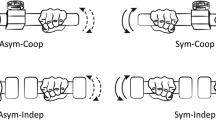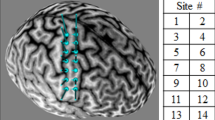Abstract
There are contralateral and less studied ipsilateral (i), indirect cortical descending projections to motoneurons (MNs). We compared ipsilateral cortical descending influences on MNs of wrist flexors by applying transcranial magnetic stimulation (TMS) over the right primary motor cortex at actively maintained flexion and extension wrist positions in uni- and bimanual tasks in right-handed participants (n = 23). The iTMS response includes a short latency (~ 25 ms) motor evoked potential (iMEP), a silent period (iSP) and a long latency (~ 60 ms) facilitation called rebound (iRB). We also investigated whether the interaction between the two hands while holding an object in a bimanual task involves ipsilateral cortical descending influences. In the unimanual task, iTMS responses in the right wrist flexors were unaffected by changes in wrist position. In the bimanual task with an object, iMEPs in the right wrist flexors were larger when the ipsilateral wrist was in flexion compared to extension. Without the object, only iRB were larger when the ipsilateral wrist was extended. Thus, ipsilateral cortical descending influences on MNs were modulated only in bimanual tasks and depended on how the two hands interacted. It is concluded that the left and right cortices cooperate in bimanual tasks involving holding an object with both hands, with possible involvement of oligo- and poly-synaptic, as well as transcallosal projections to MNs. The possible involvement of spinal and transcortical stretch and cutaneous reflexes in bimanual tasks when holding an object is discussed in the context of the well-established notion that indirect, referent control underlies motor actions.





Similar content being viewed by others
References
Alagona G, Delvaux V, Gérard P, De Pasqua V, Pennisi G, Delwaide PJ, Nicoletti F, Maertens de Noordhout A (2001) Ipsilateral motor responses to focal transcranial magnetic stimulation in healthy subjects and acute-stroke patients. Stroke 32(6):1304–1309
Asatryan DG, Feldman AG (1965) Biophysics of complex systems and mathematical models. Functional tuning of nervous system with control of movement or maintenance of a steady posture. I. Mechanographic analysis of the work of the joint on execution of a postural task. Biofizika 10(5):837–846
Bradnam LV, Stinear CM, Byblow WD (2013) Ipsilateral motor pathways after stroke: implications for non-invasive brain stimulation. Front Human Neurosci 7:184
Capaday C (1995) The effects of baclofen on the stretch reflex parameters of the cat. Exp Brain Res 10(2):287–296
Carson RG, Riek S, Smethurst CJ, Párraga JFL, Byblow WD (2000) Neuromuscular-skeletal constraints upon the dynamics of unimanual and bimanual coordination. Exp Brain Res 131(2):196–214
Chen R, Gerloff C, Hallett M, Cohen LG (1997) Involvement of the ipsilateral motor cortex in finger movements of different complexities. Ann Neurol 41:247–254
Chen R, Yung D, Li JY (2003) Organization of ipsilateral excitatory and inhibitory pathways in the human motor cortex. J Neurophysiol 89(3):1256–1264
Cohen J (1988) Statistical power analysis for the behavioral sciences. Abingdon.
Deng ZD, Lisanby SH, Peterchev AV (2013) Electric field depth–focality tradeoff in transcranial magnetic stimulation: simulation comparison of 50 coil designs. Brain Stimul 6(1):1–13
Evarts EV (1973) Motor cortex reflexes associated with learned movement. Science 179(4072):501–503
Feldman AG (1986) Once more on the equilibrium-point hypothesis (lambda model) for motor control. J Mot Behav 18:17–54
Feldman AG (2015) Referent control of action and perception. Challenging conventional theories in behavioral neuroscience. Springer, NY
Feldman AG (2019) Indirect, referent control of motor actions underlies directional tuning of neurons. J Neurophysiol 121(3):823–841
Feldman AG, Orlovsky GN (1972) The influence of different descending systems on the tonic stretch reflex in the cat. Exp Neurol 37(3):481–494
Feldman AG, Zhang L (2020) Eye, head movements and vestibulo-ocular reflex in the context of indirect, referent control of motor actions. J Neurophysiol 124(1):115–133
Frenkel-Toledo S, Yamanaka J, Friedman J, Feldman AG, Levin MF (2019) Referent control of anticipatory grip force during reaching in stroke: an experimental and modeling study. Exp Brain Res, pp 1–18.
Georgopoulos AP, Kalaska JF, Caminiti R, Massey JT (1982) On the relations between the direction of two-dimensional arm movements and cell discharge in primate motor cortex. J Neurosci 2(11):1527–1537
Gorniak SL, Feldman AG, Latash ML (2009) Joint coordination during bimanual transport of real and imaginary objects. Neurosci Lett 456(2):80–84
Hammond PH (1956) The influence of prior instruction to the subject on an apparently involuntary neuro-muscular response. J Physiol 132(1):17
Heinen F, Glocker FX, Fietzek U, Meyer BU, Lücking CH, Korinthenberg R (1998) Absence of transcallosal inhibition following focal magnetic stimulation in preschool children. Ann Neurol 43(5):608–612
Ilmane N, Sangani S, Feldman AG (2013) Corticospinal control strategies underlying voluntary and involuntary wrist movements. Behav Brain Res 236:350–358
Jang SH, Park KA, Ahn SH, Cho YW, Byun WM, Son SM, Choi JH, Kwon YH (2009) Transcallosal fibers from corticospinal tract in patients with cerebral infarct. NeuroRehabilitation 24:159–164
Jean-Charles L, Nepveu JF, Deffeyes JE, Elgbeili G, Dancause N, Barthélemy D (2017) Interhemispheric interactions between trunk muscle representations of the primary motor cortex. J Neurophysiol 118(3):1488–1500
Kelso JS (1995) Dynamic patterns: The self-organization of brain and behavior. MIT Press, Cambridge
Mara CA, Cribbie RA (2012) Paired-samples tests of equivalence. Commun Stat Simul Comput 41:1928–1943
Matthews PBC (1959) A study of certain factors influencing the stretch reflex of the decerebrate cat. J Physiol 147(3):547–564
Meyer BU, Röricht S, Von Einsiedel HG, Kruggel F, Weindl A (1995) Inhibitory and excitatory interhemispheric transfers between motor cortical areas in normal humans and patients with abnormalities of the corpus callosum. Brain 118(2):429–440
Netz J, Lammers T, Homberg V (1997) Reorganization of motor output in the non-affected hemisphere after stroke. Brain 120:1579–1586
Ostry DJ, Feldman AG (2003) A critical evaluation of the force control hypothesis in motor control. Exp Brain Res 153(3):275–288
Perez MA, Butler JE, Taylor JL (2013) Modulation of transcallosal inhibition by bilateral activation of agonist and antagonist proximal arm muscles. J Neurophysiol 111(2):405–414
Pilon JF, De Serres SJ, Feldman AG (2007) Threshold position control of arm movement with anticipatory increase in grip force. Exp Brain Res 181(1):49–67
Planck M (1950) Scientific autobiography and other papers (trans: Gaynor F). William and Norgate Ltd, London, p 191
Priori A, Berardelli A, Inghilleri M, Accornero N, Manfredi M (1994) Motor cortical inhibition and the dopaminergic system: pharmacological changes in the silent period after transcranial brain stimulation in normal subjects, patients with Parkinson’s disease and drug-induced parkinsonism. Brain 117(2):317–323
Rábago CA, Lancaster JL, Narayana S, Zhang W, Fox PT (2009) Automated-parameterization of the motor evoked potential and cortical silent period induced by transcranial magnetic stimulation. Clin Neurophysiol 120(8):1577–1587
Raptis H, Burtet L, Forget R, Feldman AG (2010) Control of wrist position and muscle relaxation by shifting spatial frames of reference for motoneuronal recruitment: possible involvement of corticospinal pathways. Physiol 588(9):1551–1570
Reis J, Swayne OB, Vandermeeren Y, Camus M, Dimyan MA, Harris-Love M, Perez MA, Ragert P, Rothwell JC, Cohen LG (2008) Contribution of transcranial magnetic stimulation to the understanding of cortical mechanisms involved in motor control. J Physiol 586(2):325–351
Rosenzweig ES, Brock JH, Culbertson MD, Lu P, Moseanko R, Edgerton VR, Havton LA, Tuszynski MH (2009) Extensive spinal decussation and bilateral termination of cervical corticospinal projections in rhesus monkeys. J Comp Neurol 513(2):151–163
Rothwell JC, Traub MM, Marsden CD (1980) Influence of voluntary intent on the human long-latency stretch reflex. Nature 286(5772):496
Sangani SG, Raptis HA, Feldman AG (2011) Subthreshold corticospinal control of anticipatory actions in humans. Behav Brain Res 224(1):145–154
Schrafl-Altermatt M, Easthope CS (2018) Cooperative hand movements: task-dependent modulation of ipsi- and contralateral cortical control. Physiol Rep 6(10):e13581
Schuirmann DJ (1987) A comparison of the two one-sided tests procedure and the power approach for assessing the equivalence of average bioavailability. J Pharmacokinet Biopharm 15:657–680
Shammah-Lagnado SJ, Negra N, Silva BA, Ricardo JA (1987) Afferent connections of the nuclei reticularis pontis oralis and caudalis: a horseradish peroxidase study in the rat. Neuroscience 20(3):961–989
Shemmell J, An JH, Perreault EJ (2009) The differential role of motor cortex in stretch reflex modulation induced by changes in environmental mechanics and verbal instruction. J Neurosci 29(42):13255–13263
Soteropoulos DS, Perez MA (2011) Physiological changes underlying bilateral isometric arm voluntary contractions in healthy humans. J Neurophysiol 105(4):1594–1602
Soteropoulos DS, Edgley SA, Baker SN (2011) Lack of evidence for direct corticospinal contributions to control of the ipsilateral forelimb in monkey. J Neurosci 31(31):11208–11219
Tazoe T, Perez MA (2014) Selective activation of ipsilateral motor pathways in intact humans. J Neurosci 34(42):13924–13934
Todd G, Taylor JL, Gandevia SC (2003) Measurement of voluntary activation of fresh and fatigued human muscles using transcranial magnetic stimulation. J Physiol 551(2):661–671
Turton A, Wroe S, Trepte N, Fraser C, Lemon RN (1996) Contralateral and ipsilateral emg responses to transcranial magnetic stimulation during recovery of arm and hand function after stroke. Electroencephalogr Clin Neurophysiol 101:316–328
Ustinova KI, Feldman AG, Levin MF (2006) Central resetting of neuromuscular steady states may underlie rhythmical arm movements. J Neurophysiol 96(3):1124–1134
Wassermann EM, Fuhr P, Cohen LG, Hallett M (1991) Effects of transcranial magnetic stimulation on ipsilateral muscles. Neurology 41(11):1795–1795
Wassermann EM, Pascual-Leone A, Hallett M (1994) Cortical motor representation of the ipsilateral hand and arm. Exp Brain Res 100(1):121–132
Yedimenko JA, Perez MA (2010) The effect of bilateral isometric forces in different directions on motor cortical function in humans. J Neurophysiol 104(6):2922–2931
Yoshino-Saito K, Nishimura Y, Oishi T, Isa T (2010) Quantitative inter-segmental and inter-laminar comparison of corticospinal projections from the forelimb area of the primary motor cortex of macaque monkeys. Neuroscience 171(4):1164–1179
Zaaimi B, Edgley SA, Soteropoulos DS, Baker SN (2012) Changes in descending motor pathway connectivity after corticospinal tract lesion in macaque monkey. Brain 135(7):2277–2289
Zhang L, Turpin NA, Feldman AG (2017) Threshold position control of anticipation in humans: a possible role of corticospinal influences. J Physiol 595(15):5359–5374
Ziemann U, Rothwell JC, Ridding MC (1996) Interaction between intracortical inhibition and facilitation in human motor cortex. J Physiol 496(3):873–881
Ziemann U, Ishii K, Borgheresi A, Yaseen Z, Battaglia F, Hallett M, Wassermann EM (1999) Dissociation of the pathways mediating ipsilateral and contralateral motor-evoked potentials in human hand and arm muscles. J Physiol 518(3):895–906
Acknowledgements
We thank Mindy Levin for helpful comments.
Funding
This study was supported by the Natural Sciences and Engineering Research Council of Canada (NSERC) for AGF, 121473-2012RGPIN. LZ was supported by the German Research Foundation (DFG).
Author information
Authors and Affiliations
Corresponding author
Ethics declarations
Conflict of interest
The authors declare no competing financial interests.
Additional information
Communicated by Winston D. Byblow.
Publisher's Note
Springer Nature remains neutral with regard to jurisdictional claims in published maps and institutional affiliations.
Rights and permissions
About this article
Cite this article
Zhang, L., Duval, L., Hasanbarani, F. et al. Participation of ipsilateral cortical descending influences in bimanual wrist movements in humans. Exp Brain Res 238, 2359–2372 (2020). https://doi.org/10.1007/s00221-020-05899-4
Received:
Accepted:
Published:
Issue Date:
DOI: https://doi.org/10.1007/s00221-020-05899-4




